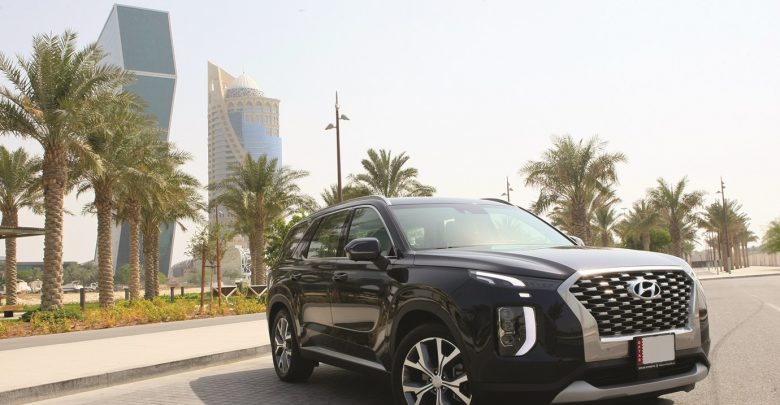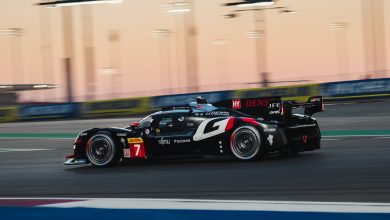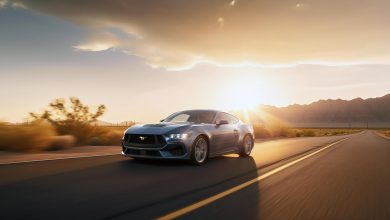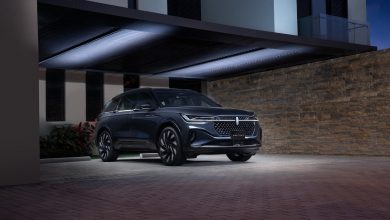
New Hyundai Palisade A perfect family car with a stylish, innovative design
«باليسيد» الجديدة.. سيارة عائلية مثالية بتصميم أنيق مبتكر
The Hyundai Palisade runs $33,000 to $47,000 and first shipments reach dealers the last two weeks of June. Drawbacks are modest: The base model, Palisade SE, lacks the blind spot detection standard on the other trim lines and detracts from an otherwise-solid safety package. Infotainment will take some trial-and-error learning. The third-row space is decent for a sub-200-inch SUV but minivans a half-foot longer are far roomier in back. The passenger seat is separate and unequal compared to the driver’s seat.
Overall, you must check out the Palisade and similar Kia Telluride if you’re shopping the Ford Explorer (also new, shipping by July), Toyota Highlander (due late this year), Honda Pilot, Subaru Ascent, and VW Atlas. The Palisade is as important to Hyundai as the midsize Hyundai Genesis sedan was a decade ago.
The Palisade replaces the three-row Hyundai Santa Fe XL while the two-row Santa Fe remains. At 196 inches, the Palisade is 3 inches longer, and a clear class above every other Hyundai on materials and cabin noise insulation. That extra length translates to a trace more legroom in front, 3 inches more in the second row, and a half-inch more in the third row. The second row also grew 3 inches of shoulder room and an inch of headroom. While Hyundai’s target demographic is the young family with two-plus kids, it’s also great on long trips for two couples.
In a day of driving early production Palisades, they proved to be excellent highway tourers. The Palisade is a decent off-roader but not a rock crawler. On potholed roads, the suspension feels a bit stiff. Inside, cabin quality, comfort, and noise suppression are exceptional. The driver assists worked well, including the semi-autonomous driving feature called Drive Assist.
Blind View Monitor: See What’s Coming Up Fast
The coolest Palisade technology is the Blind View Monitor, an enhancement to the blind-spot detection system. When you flick the turn-signal stalk, angled rear camera views of the left or right lanes appear in the instrument panel. You get audible alerts and a video look at what’s happening in the blind spot. The views are wider than what you see in the side mirrors. This is what Honda Lane Watch could have and should have become; Lane Watch is a right-side-only camera with the output displayed on the center stack, knocking out effective access to navigation or infotainment. Honda is an engineering-centric company and when somebody out-engineers Honda, that’s worth appreciating.
Hyundai Blind View Monitor is on the premium Limited model with its 12.3-inch LCD instrument panel. The panel comprises two circular gauge clusters left and right (inset photo), flanking a rectangular multi-information display. Hit the left turn signal and you get a view of what’s in your left blind spot in the left gauge circle (photo above), plus visual and audible alerts. When it comes to tracking cars that might be in your blind spot, it’s reassuring to be able to double-check the audible and visual alerts with a virtual peek over your shoulder that doesn’t require you to twist in your seat to make sure the side mirrors didn’t miss anything. This is one of the few Limited features that isn’t available on the mid-range SEL. The only way Blind View Monitor could be better is if you could preview the blind spot before pressing the turn signal, either with a partial push on the turn stalk, or left- and right-view buttons on the steering wheel. BVM is especially useful for older drivers who have trouble turning their necks, and others who can but can’t be bothered.
Drive Assist Brings Level 2 Autonomy
If Blind View Monitor is the coolest tech, the most important is Hyundai Drive Assist, meaning the car stays in lane on the highway, maintains a fixed speed, and slows or stops if the car ahead stops. To make this Level 2 hands-off driving happen, you have to keep your hands lightly on the wheel or at least every 10 seconds (so the car knows you’re still there). It’s on par with Nissan Pro Pilot Assist or, for that matter, Tesla Autopilot without the Tesla puffery. As with most competing cars, engaging L2 autonomy takes more than one step to engage, but then so does engaging adaptive cruise control.
Drive Assist is part of Hyundai’s safety umbrella called Hyundai SmartSense. Drive Assist is standard on the Limited, one of many options on SEL, and not on SE. I found Drive Assist always maintained the chosen following distance, did not veer out of lane on interstates, occasionally drifted out of lane on tighter curves on non-interstate limited access roads, and was surprised by a car cutting in just ahead of you (every other L2 car is, too), all of which represents the state of the art today. These are not defects. They’re what you get in 2019. They will help make long trips safer and more enjoyable.
Drive Assist will adapt to the speed limit in effect (when the map data was loaded into the car) and drop you from, say, 65 mph to 55 mph in an urban area. But Hyundai doesn’t do speed limit sign recognition, a drawback, and it doesn’t allow drivers to input an offset of, say, 5, 7 or 10 mph over the posted limit, which ignores American driving norms. Coincidentally, the new Ford Explorer — likely to be the closest competitor of Palisade — also adapts to speed-limit signs and it allows drivers to travel X mph over the posted limit to keep up with traffic.
Infotainment: Great Premium Audio, Decent Navigation
See the USB jack in the back of the front seatback? Hyundai has two of them there, for a total of five USB jacks in the base Palisade SE, seven on the premium Limited, and seven on properly optioned midgrade SELs. This is just one example of how Hyundai nailed it on infotainment.
With the 10.3-inch LCD on Limited and optionally on the mid-tier SEL, you can have three on-screen windows open at one time. Navigation works passably well. Now that Hyundai and most others offer Android Auto and Apple CarPlay, you may find yourself using Waze because of its superior traffic and cop reporting. You can have two smartphones connected by Bluetooth to the car simultaneously on some trim lines.
When back-seat passengers are snoozing, you can direct audio only to the front speakers. It’s called Rear Seat Quiet Mode. Conversely, when kids are raising hell in back, the Palisade now employs the STFU button pioneered by the previous generation Toyota Highlander. It’s more politely called Driver Talk In-Car Intercom and lets the driver broadcast to the middle and rear seats, momentarily shutting off any audio player back there, and advising the kids to calm down or else.
The 630-watt Harman Kardon premium audio with 12 speakers sounded fabulous. It’s only on the Limited and sounded especially good using a Harman sampler music set with uncompressed WAV files. Harman’s Clari-Fi software improves low-bit-rate music files, but there’s nothing like uncompressed if you have good ears.
You may have challenges finding the secondary features of the infotainment system. Similarly, the nine buttons in a row just below the vents may be difficult to locate and press because with nine soldiers in a row, with black on satin chrome lettering, they’re tough to quickly identify. In terms of design, the long row does look nice.
The Limited has a head-up display. In size and brightness, it’s good, but not great. It’s poor if you use polarized sunglasses. Hyundai shows blind spot information in the HUD, which is really useful.
Solid Safety Features
Hyundai has a strong set of standard safety features: forward collision-avoidance assist with pedestrian detection, lane keep assist, rear parking sonar, and camera (the camera mandated), drowsy driver alert (Driver Attention Warning), and trailer sway assist. That’s in addition to the mandatory stability control and anti-lock braking features. Hyundai says the Palisade was engineered to earn the top Department of Transportation and IIHS ratings, which are pending.
The Limited includes a 360-degree surround vision camera system which keeps your bumpers and side body panels safe. You can also see pets or children running toward the car when dad or mom pulls in the driveway.
Do competent parents accidentally leave children or pets in the car? Every Palisade has a check-rear-seats warning when you stop the engine. The SEL (optional) and Limited (standard) also have an ultrasonic sensor that notices children and pets in the back. If you leave without them, the car warns you, and if telematics is enabled, it sends a message to your phone. The counterpoint: If you have so many kids you lose track of them in your vehicle, maybe it was time for that vasectomy two or three children ago.
Three Palisade Trim Lines
The 2020 Hyundai Palisade comes in three trim lines: a) affordable but missing a key safety feature (SE), b) about what you need and customizable (SEL), and c) OMG it’s gorgeous and almost fifty grand (Limited). All come with three rows of seating, a 3.8-liter V6 engine with gasoline direct injection, and an eight-speed automatic transmission. EPA fuel-efficiency ratings are fair, but not great for a midsize SUV: city / 26 mpg highway / 22 mpg overall for city driving, 19/24/21 highway. Prices here include the $1,045 freight charge. All-wheel drive adds $1,700 to the price. Weight ranges from 4,127 pounds (front-drive, second-row bench seat) to 4,387 pounds (AWD, captain’s chairs).
To simplify trim line explanations, here are all the features that are unavailable on the entry SE, optional on SEL, and standard on Limited: front parking sonar, self-leveling rear suspension, LED headlamps and taillights, hands-free rear liftgate, ventilated front seats, an eight-way power driver’s seat, heated second-row seats, third-row power folding / unfolding / reclining seats, heated steering wheel, 10.25-inch center stack touchscreen with navigation, multiple device (phone) connections, Driver Talk rear seat paging, Qi wireless charging, and Blue Link telematics. For more detail:
Palisade SE, $32,595 front-drive / $34,295 all-wheel-drive. The SE caries eight with its standard second-row bench seat. The roof AC vents have a diffuser design that can be adjusted so the passenger gets plenty of cool air, but not a directed blast of cold. The alloy wheel/tire package is 245/60R18. It gets an 8-inch center stack display and a smallish monochrome multi-information display in the instrument panel. The only options are paint and fabric-upholstery color. Lack of blind spot detection makes the SE model undesirable; fortunately, this will be only about 10 percent of production, Hyundai says.
Palisade SEL, $34,545 FWD / $36,245, a $1,950 jump over the SE. It adds the blind spot detection/rear cross-traffic alert the SE lacks. You can choose the second-row bench seat or captain’s chairs, same price. A single-panel sunroof over the front seats is standard.
Two mostly useful packages bring the SEL halfway between the base SEL and Limited, $39,145 FWD / $40,485 AWD. The Convenience Package, $2,200, actually $3,100 including a mandatory $900 sunroof, has 20-inch alloys, aut0-leveling rear suspension, LED taillights, a hands-free liftgate, a 7-inch instrument panel LCD, rear side sunshades (kids love them), third-row USB ports, and an AC outlet. The Premium Package, $2,400, actually $5,500 including the mandatory Convenience Package and sunroof, adds leather seats, premium dashb0ard trim, bi-LED headlamps, an eight-way power seat, integrated memory for driver seat and mirrors, heated steering wheel, and power folding / reclining third-row seats.
You can add the power sunroof as a standalone option. But try to add the standalone-option Drive Guidance (navigation, 10.25-inch LCD, Highway Drive Assist, satellite radio, HD radio, Driver Talk, multiple device connections, Blue Link telematics), and you’ll find you must also take the Convenience Package.
Palisade Limited, $45,745 FWD / $47,445 AWD. Visually, it gets a different front grille with more horizontal elements. The 12.3-inch LCD instrument panel is exclusive to the Limited, as is HK audio, and a dual sunroof with a massive fixed rear panel. As with the entry SE, you just pick the exterior and interior colors. If you’ve got the money, go for it. The first two rows are at least as room as an Escalade.
Room to Improve the Palisade
When that first Hyundai Genesis (now Genesis G80) arrived as a 2009 model, it packed a lot of luxury into a $36,000 midsize sedan. One modest drawback: The driver got a power-ventilated seat but not the passenger. Now the Palisade’s front seats on the SEL and Limited are ventilated for both driver and passenger. But the passenger on the Palisade must make do without lumbar support and power adjusters. Or maybe Hyundai felt the need to shave 5-10 pounds of weight.
Residents of cold-weather cities shouldn’t have to pay $5,500 in Russian nesting doll packages to get a heated steering wheel on SEL. Nor $4,350 to get satellite and HD Radio. As a BMW exec said 10 years ago when HD radio was a costly extra, “The next version of HD radio is gonna be called ‘radio.’”
We’re hoping for a hybrid — or better, a plug-in hybrid — version of the Palisade. For car-pooling duty, a 25-mile PHEV battery could push mpg well into the thirties. History says oil won’t be cheap forever. Hyundai, remember, is the company whose stable includes two hybrids, two plug-in hybrids, two EVs, and one hydrogen fuel-cell, none of them larger than a midsize vehicle.
Should You Buy the 2020 Palisade?
The 2020 Hyundai Palisade is a great three-row SUV for people who want three-row SUVs. It is also a great-big SUV, bordering on being full-size. There are a half-dozen serious Palisade competitors, many of then new or recently refreshed. The sixth-generation Ford Explorer just launched and is the most direct competitor. The Explorer drivetrain is now rear-drive-based while the Palisade is a front-wheel-drive-based design. The Explorer is the best-selling midsize SUV, with 262,000 US sales last year and 7.5 million sold in the US since 1990. Shoppers may find the Palisade interior slightly more upscale. A fully equipped Explorer Platinum runs $61,000, $13,000 more than the tip-top Palisade. That’s BMW X5 territory. Almost.
The fourth-generation Toyota Highlander arrives late this year, on a new platform, stretched to within an inch of the Palisade. It will have four-cylinder gas and hybrid versions as well as a V6. The hybrid should get 34 mpg combined, 50 percent better than the Palisade. Highlander sold 245,000 units last year, second to the Explorer. SUVs 3-4-5 on the 2018 sales list, the Jeep Wrangler, Jeep Grand Cherokee, and Subaru Outback, are midsize in capacity but are not direct competitors and seat five at most. The No. 6 Honda Pilot had its best year ever in 2018, with 160,000 sold, and got a refresh for 2019. But the Pilot is feeling its age. The Honda Sensing safety suite is now standard on all trim lines, but blind spot detection is not part of Honda Sensing and, like the Palisade, BSD doesn’t come standard on the lowest of Pilot’s five trim lines. Pilot’s infotainment system annoys users with a volume knob but no tuning knob. At least Pilot no longer has LaneWatch.
Regardless of their sales, two international competitors may be capable of taking on the Palisade: the Subaru Ascent and Volkswagen Atlas. The Nissan Pathfinder is sized like the Palisade but dates to the 2013 model year with a refresh in 2017, and it remains less competitive. All offer three-row seating.
Among similarly sized US vehicles, the Chevrolet Traverse and upscale twin GMC Acadia are roomy and less expensive, but the interior doesn’t match the Palisade. The Buick Enclave, the sibling to the Traverse, has a more upscale interior but the top end runs almost $10K more than Palisade. The biggest Jeep, Grand Cherokee, is a five-seater. The Dodge Durango is your SUV if want a muscle car that seats seven.
Not one of these vehicles is as roomy, especially in row three, as the Honda Odyssey, Toyota Sienna, or Chrysler Town & Country minivans.
As for the Kia Telluride, there is a lot of similarity to the Palisade, including the engine, transmission, and general structural design. Broadly, the Telluride plays up off-roading where the Palisade focuses on cockpit style and on-road driving comfort. But (full-width photo above) the Palisade does well off-road, too, and hauls 5,000-pound trailers. Most dimensions are similar. The Telluride finds an extra 3 cubic feet of storage behind the third-row seats. The Telluride is $140-$115 cheaper depending on trim level. The Palisade / Telluride pair will eat into Ford Explorer sales more on the coasts while the Explorer will remain strong in heartland America. But Explorer will likely take sales from the less-capable SUVs.
The 2020 Hyundai Palisade is pretty much the largest thing the Hyundai conglomerate builds without anchors, which is the kind of size Americans and American backsides appreciate. The Palisade will be a hit. A lot of editors have the Palisade shortlisted for car-of-the-year and top-ten consideration. Just as they’ve done for the 2020 Explorer. The Palisade is a true class-above vehicle for Hyundai, much as Mazda has done with the CX-5 compact SUV and the Mazda3 sedan and hatchback.
In fact, the Hyundai Palisade is so well-executed and so upscale, it puts pressure on the Hyundai group’s premium brand, Genesis, to go beyond what the Palisade has done. Look for the GV80 unveiling this fall and shipments in the first half of 2020.
source: extremetech.com
بدعوة من شركة سكاي لاين -الوكيل المعتمد لعلامة هيونداي العريقة في قطر- اختبرت «صحيفة العرب» تجربة قيادة المركبة الفاخرة والجديدة كلياً «هيونداي باليسيد»، بعد أن اختبرتها منذ فترة وجيزة في كوريا الجنوبية تزامناً مع ظهورها الأول، وهاهي اليوم تختبرها مرة أخرى على طرق الدوحة المختلفة، وتشكّل المركبة الجديدة كلياً «باليسيد» إضافة جريئة إلى تشكيلة طرز «هيونداي» من المركبات الرياضية متعددة الاستخدامات، حيث تأتي هذه المركبة المتوسطة الحجم، ذات الأبعاد الأكبر طولاً وعرضاً وارتفاعاً من أبعاد مركبة «هيونداي» الشهيرة سانتافي، مبنية على شاصيه جديد كلياً صمم خصيصاً للمركبات الرياضية متعددة الاستخدامات مع رحابة استثنائية لمقاعد الصفين الثاني والثالث في المقصورة التي تضم ثمانية مقاعد، إلى جانب منطقة واسعة للشحن ومرونة في إعادة تشكيل المقاعد.
تأتي المركبة الجديدة في باقة من التصاميم الأنيقة والمبتكرة، إذ تتميز بتصميم خارجي وتشطيبات داخلية فاخرة، مع مستويات جديدة من قدرات القيادة على جميع الطرق وفي الأحوال الجوية كافة، فضلاً عن الكفاءة في القيادة وتقنيات الراحة والسلامة، ومزايا الرحابة الداخلية.
سيارة مثالية
تعتبر «باليسيد» الجديدة كلياً من «هيونداي»، بأنها سيارة عائلية مثالية تتميز بأناقتها وإمكانياتها العملية، وهندستها التي تُظهر الاهتمام براحة جميع الركاب وسلامتهم. وتشكل المركبة باليسيد إضافة مهمة إلى المركبات الرياضية متعددة الاستخدامات الرائدة في فئاتها، وهي أكبر حجماً بدرجة واحدة مقارنة بالطرز الحالية، مقدمة للمستخدمين خياراً تنافسياً جديداً في فئتها.
طابع بهي
ويُضفي تصميم «باليسيد» على المركبة طابعاً بهياً يشي بأناقة لا تكلّف فيها جديرة بالمركبات الرياضية الفاخرة متعددة الاستخدامات. ففي المقدمة، تحيط المصابيح الأمامية المركبة ذات الإنارة العمودية المتصلة، بالشبك الكبير ذي الفتحات متوالية الانحدار، كما يخلق المظهر الجانبي القوي والممتد لمقدمة المركبة، حضوراً مثيراً للإعجاب على الطريق، بينما توضّح الأعمدة الجانبية الخلفية العريضة والنوافذ الجانبية البانورامية المساحة الواسعة للمقصورة، أما الجوانب والرفارف الممتلئة فتُبرز ما تتمتع به المركبة من قوة ومهابة.
الرحابة والراحة
ويجمع التصميم الداخلي للمقصورة بين الشعور بالراحة والاسترخاء، ما يخلق بيئة هادئة للمغامرات العائلية وأجواء فسيحة ومريحة. وتمّ التركيز على المزايا التي تحظى بتقدير العائلات، ووجود سبعة منافذ USB موزعة في صفوف المقاعد الثلاثة، و16 حاملاً للأكواب. ويشتمل نظام الصوت على وظيفة اتصال داخلي «Driver Talk»، تمكّن السائق من التحدث المباشر بهدوء مع الركاب في الصفوف الخلفية، واختيار نمط «الهادئ» الذي يقوم بإيقاف تشغيل السماعات الخلفية، في حين يتيح للسائق والراكب الأمامي مواصلة الاستماع إلى الصوت. وتأتي «باليسيد» بفتحات تهوية تكييف ذات تصميم مبتكر، لتتيح انسياب الهواء بهدوء ومرونة عالية، من أجل ضمان أجواء مريحة لجميع الركاب.
وتضم الهيئة الأمامية في المقصورة شاشة النظامين الصوتي والملاحي العاملة باللمس، والتي تأتي بهيئة عريضة بقياس 10.25 بوصة. ويمكن توصيل جهازين بالمركبة في وقت واحد عبر البلوتوث، فيما تتكامل أنظمة المعلومات والترفيه مع النظامين Android Auto وApple CarPlay، وهناك لوحة شحن لاسلكي لإمداد الأجهزة المحمولة المتوافقة مع تقنية الشحن اللاسلكي، بالطاقة. ويحل زر تغيير التروس بالسلك محل عصا تغيير التروس التقليدية، من أجل توسعة المساحة المتاحة في الكونسول الوسطي. ويعمل جهاز العرض العلوي -في المقدمة- على عرض معلومات القيادة المهمة، كالسرعة وإرشادات الملاحة، وعلى الزجاج الأمامي على امتداد خط نظر السائق لضمان تركيزه الدائم على الطريق.
وأكد سونغ أن «هيونداي» تواصل توظيف التقنيات المتقدمة لإثراء تجربة السائق والركاب، مشيراً إلى مجموعة الابتكارات التي تتميز بها «باليسيد»، والتي من شأنها «جعل القيادة أكثر استرخاءً وأقل توتراً، وتضمن تمتّع كل راكب برحلته على متن المركبة».
هيكل صلب
ويساهم هيكل «باليسيد» شديد الصلابة في تعزيز حماية الركاب، لا سيما مع التراكيب الهيكلية السفلية والجانبية القوية التي تعمل على زيادة تشتيت الطاقة في حال وقوع أي اصطدام. وتحتوي المركبة الجديدة على ست وسائد هوائية قياسية: اثنتان أماميتان، واثنتان على كل من الجانبين. وتأتي «باليسيد» مزوّدة بعدد من تقنيات السلامة المعيارية المتقدمة التي تشمل أنظمة متطوّرة لمساعدة السائق ضمن باقة تقنيات السلامة «سمارت سينس» من «هيونداي».
وتشمل مزايا باقة «سمارت سينس»: المساعدة على تجنب الاصطدام الأمامي، والمساعدة على تجنب الاصطدام عند النقطة العمياء، وشاشة كاشفة للنقطة العمياء، والمساعدة على البقاء في المسرب، والمساعدة على تجنب الاصطدام عند عبور السيارات من الخلف، والمساعدة على الخروج بأمان من المركبة، وتنبيه بوجوب راكب في المقاعد الخلفية، والمساعدة في الضوء العالي، وتحذير السائق من قلّة الانتباه، ونظام سرعة ذكي متوائم مع حركة المرور، بميزة التوقف والانطلاق.
أنماط متعددة
كما تشهد «باليسيد» تطبيق نظام هيونداي «للتحكم بالقيادة بأنماط متعددة» لأول مرة، حيث يتيح هذا النظام للسائق الاختيار بين ثلاثة أوضاع مختلفة وفقاً للظروف التي يراها، وهي أوضاع الطرق الرملية والموحلة والثلجية، حيث يعمل وضع الطرق الثلجية على الحد من انزلاق العجلات على الأرضيات الجليدية أو المكسوة بالثلج لتأمين المزيد من الثبات للسيارة.
أما وضع الطرق الموحلة، فيسمح بتطبيق عزم دوران أكثر قوة مع التحكم برفع السرعة بناقل الحركة، أو منعها لمساعدة العجلات على الدوران بقوة أكبر، والمحافظة على الزخم والقوة على الطرق الموحلة، في حين أن وضع الطرق الرملية يعمل على منع العجلات من الحفر والانغراز في الرمل عبر التحكم في توزيع عزم الدوران الأمثل على العجلات الأربع حسب الحاجة.
المصدر: alarab.qa



